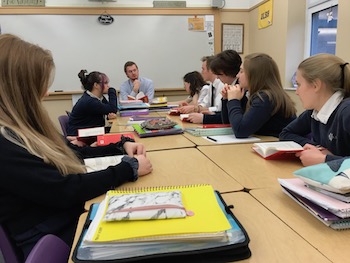Learning to Do More with Less: Thoughts around Assessment...and Marathons
Chris Judson - English Content Director, AP-TIP IN

When my friend Tom suggested to me one day that we should run a marathon, I jumped at the chance.
Or, at least I thought it sounded like a good idea at the time.
I remember asking him, “How do I prepare for running a marathon?” as I had little experience with long distance running. Tom recommended a popular training schedule that would just get me to the finish line.
By fixating on the long weekend runs, I was able to finish my first marathon successfully. But, as I continued training and running marathons for the next few years, I grew frustrated with my results.
I really had no idea why I wasn't improving much, if at all, on my finish times. I had to change my training schedule to challenge my thinking around what I was emphasizing and how I was improving. Instead of focusing on those long runs on the weekends, my new philosophy focused on shorter weekday runs.
In short: I was learning to do more with less.
And I've been thinking about that change in my philosophy of running with the recent changes in education due to Covid-19. As we have moved our normal classroom to an online environment, our pedagogy and how we think about what we ask students to do and how that informs our assessment of learning has been challenged.
Our Advanced Placement Teacher Investment Program (AP-TIP IN) team works with teachers who had to adjust their own philosophies when the College Board announced that they would be reducing the time of the year-end exam from 3 hours to 45 minutes and would be changing the focus of the exam from two parts or modes of assessment to one essay or two short responses.
In that original marathon training schedule, which is where many beginning runners start, the long run--a single run on the weekend that increases incrementally from 5 miles to one of 20 miles-- has long been the focus.
The problem with this focus is obvious: everything about the success of that week's training depends on a single run. What happens if you're sick or you don't have the time to complete it? Or—speaking from experience—what if you try to run 18 miles on a warm day after visiting a pizza buffet for lunch an hour before your run? And what happens to your confidence in running a 26.2-mile marathon if you miss out on your 20-miler three weeks before the race?
After a few years of frustration over my lack of improvement, I stumbled upon a newer training schedule that deemphasized the obsession of long runs and instead focused on what they termed SOS (Something of Substance) training.
Now the longest run would be 16 miles, but the focus then was on a variety of runs during the week. These would include runs to improve speed and strength, getting used to running at your specific target pace (tempo runs), regular "fluency" runs, and prescribed days of rest.
 In the classroom, I have seen teachers make similar shifts with regard to instruction. Often an emphasis is placed on the completion of tasks and on the larger events; and the decision of what is due and when is only made by the teacher. The assessment of classwork, then, is not of quality and growth but more of compliance.
In the classroom, I have seen teachers make similar shifts with regard to instruction. Often an emphasis is placed on the completion of tasks and on the larger events; and the decision of what is due and when is only made by the teacher. The assessment of classwork, then, is not of quality and growth but more of compliance.
No wonder there has been a national conversation about what to do with all the zeros in the grade book and whether or not students should fail because they choose not to turn in our traditional assignments.
Just as I learned in my marathon training, the teachers transitioning to an online environment are also realizing they need to “do more with less” and differentiate whether assignments foster authentic student learning or mere compliance.
I think of how our program and affiliate teachers have let go of the Powerpoint presentations with voice-overs and instead have narrowed the instruction to what students need to know and do in a particular essay.
Online instruction has moved away from watching a variety of TedTalks or merely viewing Khan Academy videos of someone else teaching a concept. Now it leverages the idea of collaborative student Google documents and short videos of student responses to their own or their peers' work. Teachers have added breakout rooms to allow for more participation in processing. As teachers have been asked to assess what was going on, assessment has moved from the mere completion of a weekly assignment to more formative assessments which inform the fluency of student learning.
 When I reflect on the past few months of this school year and the time spent walking alongside teachers and their students, I believe that adapting to an unexpected situation has moved them to think about more effective ways to both encourage and measure student learning.
When I reflect on the past few months of this school year and the time spent walking alongside teachers and their students, I believe that adapting to an unexpected situation has moved them to think about more effective ways to both encourage and measure student learning.
As I think back on my transition to a new training schedule and that time of reflection and understanding my own running (not someone else's idea of a one-size-fits-all, just-get-to-the-finish-line compliance model), I was able to assess my own progress with those more frequent and focused runs.
For me, that change allowed me to look forward to the daily and weekly runs and even those days of rest – and take 37 minutes off my best time.
Learn more about the Advanced Placement Teacher Investment Program at iei.nd.edu/aptipin.


